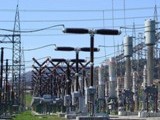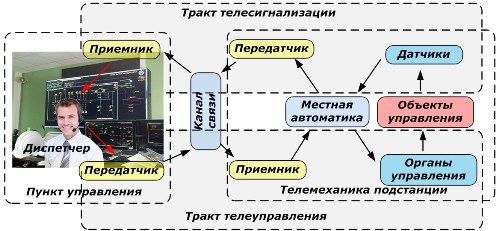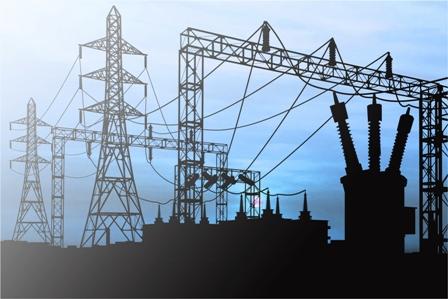Remote control in electrical networks
 Structurally, electrical networks on a regional or regional scale consist of a large number of interconnected objects:
Structurally, electrical networks on a regional or regional scale consist of a large number of interconnected objects:
-
substations located near populated areas;
-
power transmission lines;
-
points of production and consumption of electricity.
The control of the technological processes taking place between them is carried out by dispatch centers that are responsible for a large number of remote substations operating in automatic mode. However, due to the importance of the tasks performed, they must be constantly monitored and, if necessary, controlled by the dispatcher. These functions are performed by two remote control systems: TU remote control and vehicle remote signaling.
The principle of operation of the remote control
On the switchgear of each substation are power switches that switch incoming and outgoing electricity through power lines.The state of the switch is repeated by its secondary block contacts, and by them intermediate relays and locking relays, the position of which is used in the signal-telemechanical circuit. They work as sensors and, like switching devices, have two meanings: "on" and "off".

The principle of operation of telemechanics
Each substation has a local signaling system that informs electrical staffperforming work on the equipment on the state of the electrical circuit by lighting the light panels and making sound signals. But for a longer time, the substation works without people, and in order to inform the dispatcher on duty about the operational situation, a telesignal system is used on it.
The switch position is assigned one of the binary code values «1» or «0», which is sent by the local automation to the transmitter connected to communication channel (cable, phone, radio).
On the opposite side of the communication channel there is a control point and a receiver of the power facility, which processes the received signals from the transmitter and converts them into an accessible form for information for the dispatcher. According to them, the state of the substation is being assessed.
However, in many cases this data is insufficient. Therefore, telesignaling is complemented by the TI telemetry system, according to which the readings of the main power, voltage, current meters are also transmitted to the control panel. By its structure, the TI circuit is included in the telemechanics kit.
The dispatcher has the ability to influence the distribution of electricity from a remote substation means of remote control... For this, he has his own transmitter that issues commands to the communication channel from the control point. At the opposite end of the transmission path, the command is received by the receiver and transmitted to the local automation to act on the controls that flip the power switch.
The telemechanical systems are serviced by the SDTU and the Communications Service, and the local automation service by the SRZA.
Types of remote control commands
The signal emitted by the dispatcher's transmitter to the control body of the substation is considered a command that requires mandatory execution.
The order can only be sent to:
-
separate object of the substation (switch);
-
a group of devices in different substations, for example, a telemechanical command to set information to provide certain information.
Features of the use of remote control
Provisioning requirements are imposed on the tasks performed by the dispatcher from the remote switching point:
-
increasing the reliability of power supply to consumers by rapidly accelerating actions;
-
maintaining the safety criteria when using electricity.
Before turning on the connection by remote control, the dispatcher takes into account that the circuit breaker of the remote substation can be turned off:
-
by the action of protections to prevent the development of an accident after trial switching on by automatic reclosing (reclosing);
-
operating personnel allowed to work in the substation from a local or remote point.
In all cases, before switching on the circuit, safety rules should be followed and reliable information gathered by a trained electrician about the readiness of the circuit for switching on load should be obtained.
Sometimes individual workers, in order to speed up the search for a short circuit that occurred on remote 6 ÷ 10 kV connections, "make a mistake" by turning on the circuit breaker under load after disconnecting part of certain consumers. In this method, in the event of failure to determine the location of the fault, a short circuit again occurs in the circuit, accompanied by increased equipment loads, power flows and other deviations from the normal mode.
Interaction of telecontrol and telesignaling
The remote control command is transmitted by the dispatcher in two stages: preparatory and executive. This eliminates errors that can occur when entering an address and action. Before the final sending of the command by starting the transmitter, the operator has the opportunity to check the data entered by him.
Each action of the TU command corresponds to a certain position of the executive bodies of the remote object, which must be confirmed by remote signaling and accepted by the dispatcher. The signal from the vehicle will be retransmitted until it is acknowledged at the receiving point.
Acknowledgment in telemechanics - the operation performed, the operator observes the signals to confirm the reception of the signal and locks it on the mnemonic diagram.The signal that reappears on the mnemonic diagram attracts the attention of the operator to change the state of the controlled object (for example, by flashing a warning lamp) and the discrepancy in the position of the warning device (symbol) state of the object. As a result of the confirmation, the signaling device must assume a position corresponding to the new state of the controlled object.
There are two methods of confirmation: individual — with the use of separate handshake keys and general — with one common for all signals with the confirmation button. In the latter case, the acknowledgment scheme is implemented using a set of individual handshake relays. In the scheme of the signaling device, the contacts of the confirmation keys or relays are connected according to the principle of non-correspondence with contacts of signal relays repeating the state of the monitored objects.
In some cases, the TR command may not be executed for various reasons. The remote control system does not have to "remember" it and duplicate it again. All additional manipulations are carried out after establishing the causes of the damage and checking the condition of the control object.
The technical condition of the communication channel must be constantly monitored by the equipment. The message transmitted through the vehicle by the transmitter must be received without distortion. Interference occurring in the communication channel should not reduce the reliability of the information.

Reliability of information
All transmitted messages from telesignaling are stored in the equipment's memory until confirmation of their receipt in the control center.If the communication channel is broken, they will automatically be transmitted after it is restored.
When transmitting a TC command to a remote substation, a situation may sometimes arise where changes have occurred in the operating environment and receiving the command will cause unwanted equipment actions or become meaningless. Therefore, for such cases, the priority action of TS messages is entered into the automation algorithm for such cases before TC commands.
Telemechanics equipment can use or use legacy analog-based devices digital technologies… In the second version, the capabilities of the equipment are significantly expanded, while the noise protection of the communication channel is increased.

